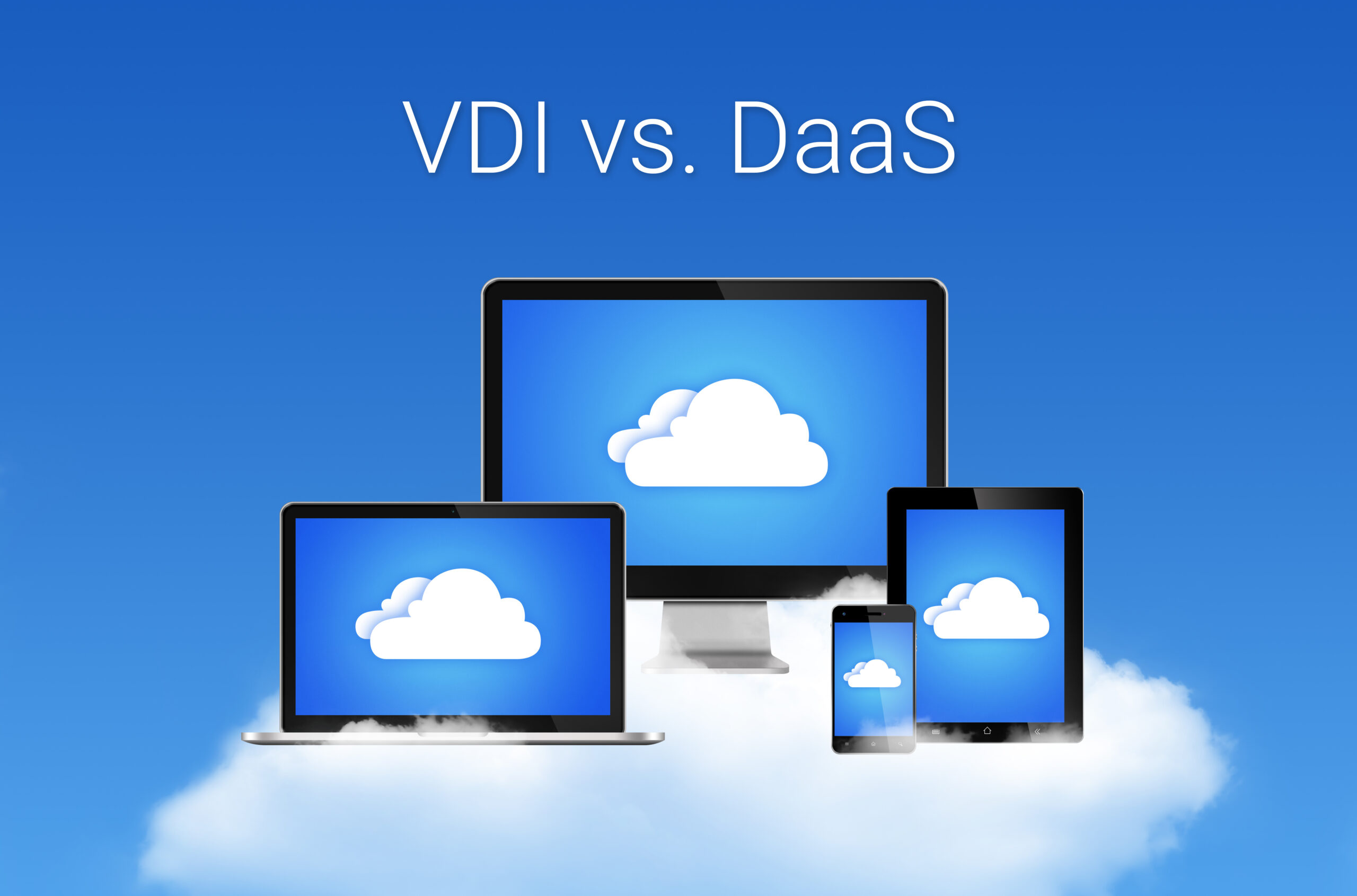If you’re beginning to explore the world of virtual desktops, you may run across the terms virtual desktop infrastructure (VDI) and Desktop-as-a-Service (DaaS) in your research. If you’re wondering what the similarities and differences are between these two terms, you’ve come to the right place. This brief primer will help define both these solutions, the pros and cons of each, and what types of companies may benefit from one versus the other.
What is VDI?
Typically, the term VDI refers to an internally based computer system that houses operating systems, software, applications, and other technologies in a central data center. All employees, contractors, customers, and other stakeholders access the company’s IT infrastructure through internal WAN, connecting on virtual desktops, laptops, tablets, smartphones, or other devices.
This type of solution allows centralized management, maintenance, and troubleshooting for the business’s IT staff instead of needing to work on every end device. This saves IT resources, which are in short supply, and helps companies run their computing systems much more efficiently.
In today’s remote work environment, VDI can be a reliable and secure solution that allows disparate employees to share resources, communicate, and access critical company data from any location. However, building one can take a significant amount of resources as the infrastructure for such a data center can be complex and expensive.
What is DaaS?
DaaS works very similar to VDI, but it typically refers to an external service provider that offers the virtual desktop solution to multiple customers in the cloud. Like VDI, all operating systems, software, applications, storage, and data are centrally stored. However, instead of residing in an on-premise data center, the system sits in cloud-based data centers, usually in geographically diverse locations.
The DaaS partner, in turn, handles all the management and maintenance of the virtual desktop system for its clients. The vendor is responsible for staying on top of the latest developments and ensuring that governance and security remain reliable and of a high quality.
That said, specific use cases may require that IT staff make additional modifications or integrations in order to ensure that the DaaS system can meet all of the needs of a particular company or organization.

The Pros and Cons of Each
Functionally, VDI and DaaS operate very much alike. One big difference between the two, though, is who is responsible for the management, implementation, and day-to-day maintenance tasks, as well as how resources are allocated.
The main advantage of VDI is maintaining internal control of the data center and the virtual desktop solution. Your organization determines the priorities and chooses when and how updates and patches are handled without waiting for a third-party vendor to deliver. However, the cost of setting up an internal data center, managing software licenses, and keeping up with technological advances can be significant. In addition, an internal IT team will be required to handle the ongoing maintenance and network latency and performance can be an issue.
Using DaaS service providers can allow companies to tap into a wealth of experience and expertise at a low-entry price. In addition, features can be customized to deliver the services that your company specifically needs. Many disadvantages result if an incompatible or inexperienced DaaS partner is selected, and companies may feel a loss of control of a virtual desktop solution if it is managed by a third party.
In addition, if an organization has a complex application for the DaaS solution, additional modifications may be required in order to ensure that the system is fully operational. This can compound the costs of integration, customization, and ongoing maintenance.
Another important distinction between VDI and DaaS is the scalability and cost implications. With VDI, scalability is limited. The infrastructure is built around meeting peak demand. The cost of that infrastructure does not decrease if demand does. In contrast, with DaaS your infrastructure cost reflects demand, you only pay for what you use. This provides huge cost savings for organizations that experience vast fluctuations. In higher ed environments in particular, where usage dramatically changes throughout the year, DaaS provides the flexibility and cost savings colleges and universities need.
An Easier Solution
Building on the strengths of both VDI and DaaS, Apporto has crafted technology that takes the complexity out of implementation, making them turnkey for client IT teams. For example, hyperstreaming capabilities are built into the solution to allow for premium audio and video transfer. Organizations such as colleges that must operate on Windows, Mac and Linux no longer have to worry about managing all these operating systems as those customizations are built into the Apporto solution. Desktop variations also come pre-packaged, lightening the load for your IT staff.
How to Decide What’s Best for You
As in making all technology-related decisions, companies must review their goals and priorities, weigh the pros and cons of available solutions, and select the option that appears to be the best fit.
Larger companies with an established data center and IT department may find that implementing a VDI is a relatively simple next step to manage remote workers. Small start-ups looking to dabble in virtual desktops may appreciate the low cost of entry from DaaS providers. Organizations seeking specific use cases that match Apporto’s expertise and offerings may prefer an easier, turnkey solution to reduce costs and IT resources required for maintenance.
Whichever category your organization falls into, virtual desktop solutions are here to stay and likely to become even more commonplace in the future. Learning about the different options now will help you be prepared to make the best decision for your organization when the time is right.
Apporto has been providing DaaS solutions to satisfied customers since 2014. Our team is made up of dedicated experts that have years of experience helping businesses just like yours take full advantage of DaaS technology. Contact us today to see our platform in action.

